Downloads
***Check against delivery***
Introduction
Good evening everyone and thank you for inviting me to come and talk to you today about tax reform.
I am particularly pleased to be talking to the Tax Institute because it is tax professionals that help so many businesses and individuals deal with the tax system at the coal face. You can also play a valuable role in helping the community understand the issues confronting our tax system and the implications of potential reform directions going forward.
Indeed, I want to spend a little time today talking about the importance of community engagement. But first I want to talk about why the Government is embarking on tax reform, before turning to some of the key issues that will need to be explored throughout the Tax White Paper process.
The need for tax reform
The need for tax reform can be seen in terms of challenges and opportunities.
I will mention three challenges: the first being the living standards challenge for Australia; the second, the impact of technological innovation and globalisation; and lastly, the ageing of the population.
Promoting growth in living standards
Australia has been relatively blessed, experiencing almost a quarter of a century of uninterrupted economic growth and strong growth in our standard of living. Previous growth has been assisted by the rise in female participation, earlier waves of economic reform and the mining boom. However, the recent Intergenerational Report projects that income growth will slow over the next 40 years (Slide 1). Some of these things we have little control over, like demographic ageing and the world price of our exports. This emphasises the need to focus on reforms that boost productivity and participation as these are the key factors that drive living standards.
Many argue that comprehensive tax reform could provide a substantial boost to living standards – indeed, a bigger boost than any other single area of government policy.
Chart 1. Sources of growth in real national income per person (from slide 1).
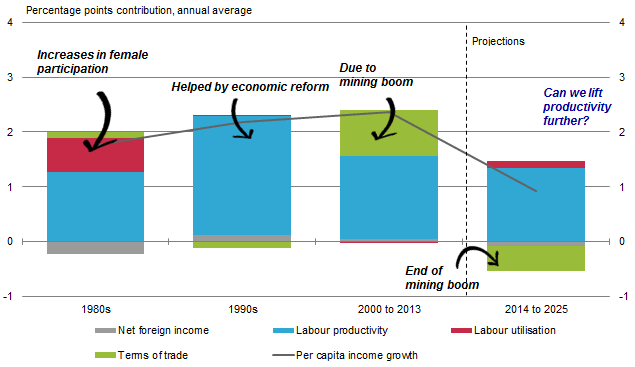
Technological innovation and globalisation
The second big challenge is technological innovation and globalisation. This is profoundly shaping our economies and our everyday lives. This has been of huge benefit to humanity. But it does also strike challenges, including for tax systems that were designed in a very different age. An example is the rapidly growing role of things that are intangible – that can be hard to value or to determine their source – in the global economy.
In the past 40 years, intangible assets have grown from less than a fifth of the market value of the S&P 500 to more than four-fifths (Slide 2). Furthermore, companies now have greater ability as to where they locate their operations. This poses a particular challenge to company tax going forward, and reinforces the need to ensure our tax rules, which are already robust, remain up to the task.
It is also reasonable to think that with globalisation, labour mobility may increase in future, particularly for highly skilled workers, which would raise the economic costs of our progressive income tax system.
Chart 2. Component of S&P 500 market value, 1975-2015 (from slide 2)
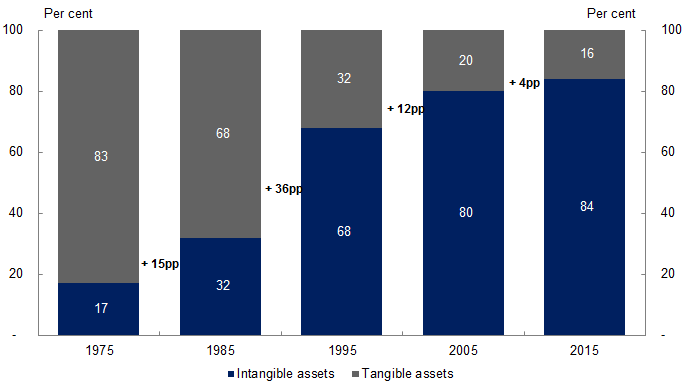
Ageing of the population
A third big challenge for our tax system is the ageing of the population (Slide 3). There will be a substantial decline in the relative size of the population of traditional working age – those who usually pay the most income tax – and this will put pressure on our tax system.
Chart 3. The number of people (aged 15 to 64) per person aged 65+ is decreasing (slide 3)
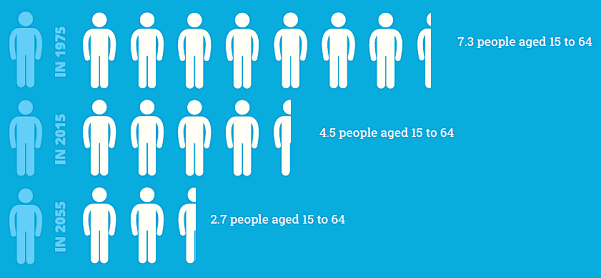
This will occur at a time when bracket creep will push more workers onto the higher tax rates. Left unchecked, a combination of inflation and real wage growth is projected to increase the percentage of taxpayers on the top two tax rates from around 27 to 43 per cent (Slide 4).
Chart 4. Bracket creep (from slide 4)
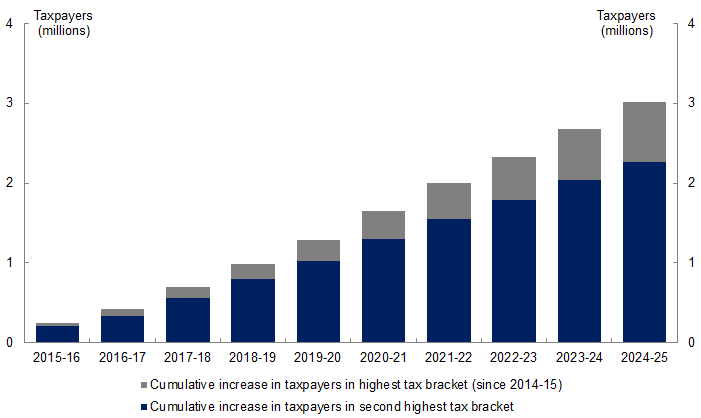
What are the opportunities available to us?
So the tax system and our economy more broadly, face some big challenges. What are the opportunities or benefits we could get from reform? It is commonplace in discussing tax reform to talk about the three tax axioms: efficiency, simplicity and fairness, and these are covered in the Government’s Tax Discussion Paper. Each presents important reform opportunities.
Efficiency
By economic efficiency, we mean the effect the tax system has on overall economic output or living standards. It is well recognised that almost all taxes have a negative effect on economic growth but some taxes have a greater effect than others.
Treasury modelling suggests that there is a wide variation in the relative costs to society of the marginal dollar of revenue raised by various taxes (Slide 5).
Chart 5. Long-run modelling estimates of the marginal excess burden of some of Australia’s taxes (from slide 5)
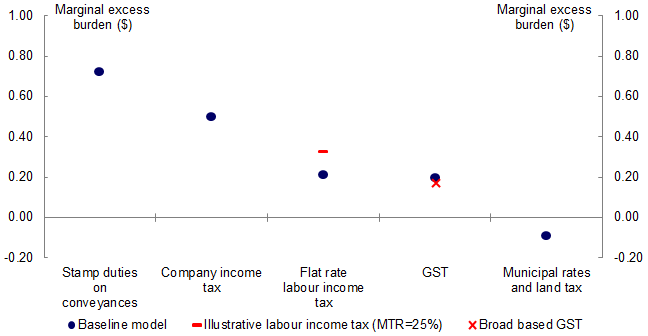
In line with other studies, it shows that stamp duties and company tax have high economic costs, while municipal rates have a low economic cost. Stamp duties, like other turnover taxes, dampen exchanges which would otherwise be mutually beneficial. Company tax has a high burden because capital is highly mobile and so the tax has a significant dampening effect on the level of investment.
The chart also shows that a progressive labour income tax, i.e., one with increasing marginal tax rates, has a higher economic burden that either a flat rate labour tax or a flat rate GST.
But what about our reliance on these tax types relative to other countries? It is worth noting that Australia has a relatively low tax burden compared to other OECD countries – so the analysis is about our relative, rather than absolute reliance on these taxes. The other thing to keep in mind is that while comparisons are instructive, there are limitations in what they can tell us, for example countries may have different economic characteristics which will tend to be reflected in differences in national tax systems.
So with that in mind, this Slide (Slide 6) shows our reliance on various broad tax types compared to the OECD average. We rely more on corporate taxes and more on progressive personal income taxes than other countries, and rely less on flat rate labour taxes and consumption taxes. And while we rely more than the OECD average on land tax, the US, Japan, United Kingdom, Canada and France have a significantly higher reliance on land taxes.
Chart 6. Major taxes as a share of total taxation, Australia compared to OECD average, 2012 (from slide 6)
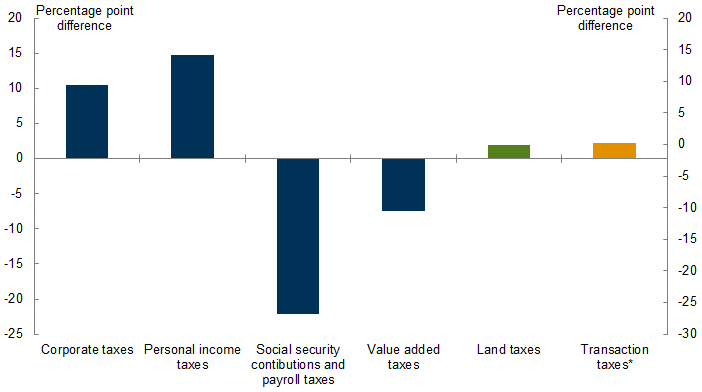
The concept of &ls
quo;efficiency’ can be challenging to translate in a tangible and relevant way for the community. Some taxes, like stamp duty, are relevant to their own experience and the impact is relatively intuitive. Others, like company tax, are more challenging. We are working to address this, by approaching community engagement in new ways, including by developing short and simple animations to explain concepts and issues – see for example the following animation ‘How company tax impacts living standards’.
Play Animation linked at
https://www.youtube.com/watch?v=jzktcbwi-Tc.
So far I have talked about the efficiency of our tax bases, but there are also important issues within tax bases.
To give just a few examples relating to income tax:
- what are the economic efficiency implications of the current tax treatment of saving and investment?
- What is the impact of the treatment of taxation of dividends, superannuation and capital gains?
- What are the consequences of the gap between the corporate tax rate and the personal tax rate?
- What is the effect of our capital depreciation rules on investment and international competitiveness?
Further, developing tax policy requires much more than maximising efficiency. The second tax axiom is fairness and as the Government has made clear, it wants taxes that are fairer.
Fairness
While fairness, or equity, is widely accepted as a fundamental design principle for the tax system, it is intrinsically subjective. At the same time, this does not mean there are no analytical tools, principles or frameworks to help inform judgements about the fairness of the tax system. Some of these include treating people in like circumstances similarly, the ability to pay principle, giving people time to adjust to new rules and rewarding effort.
One of the big challenges for people in thinking about the fairness of the tax system is to understand the difference between the legal incidence of tax and who actually bears it. While workers understand they pay for the GST (even though the legal incidence falls on businesses), they might be surprised to hear that they bear much of the economic cost of company tax and payroll tax. Recent research by the Treasury1 indicates that, in the long run, much of the burden or incidence of company tax falls on Australian workers – this point is made in the animation I showed you earlier.
Another big challenge is that it is much easier to think about the fairness of a particular tax, rather than the whole of the tax/transfer system. In fact, Australia has a highly progressive tax/transfer system by international standards (Slide 7).
Chart 7. Cash transfer payments and taxes as a percentage of gross income, 2009-10 (from slide 7)
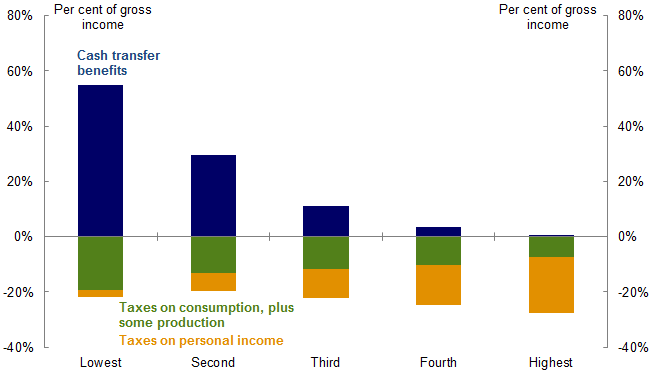
This progressivity is primarily due to the combination of our targeted transfer system, the absence of social security taxes and our relatively high tax free threshold.
So far I have discussed efficiency and equity, and now I will touch on complexity.
Complexity
Whilst some complexity in a tax system is inevitable, you more than most know that our system is incredibly complex and this imposes substantial costs to the community, both directly and indirectly through increased uncertainty and risk.
In fact, the Australian Taxation Office (ATO) estimates that total tax compliance costs are in the order of $40 billion per year.2
Now it is fair to say that past reform efforts have not been spectacularly successful in reducing complexity. And over the years ‘business as usual’ tax changes have added rather than subtracted complexity to our system. While there is no silver bullet, this tax white paper process does provide an opportunity for rebalancing our approach to drive down complexity and cost. The tax community can play a particularly important role in helping shape how we can make the system simpler over time.
Trade Offs and Community Choice
Public policy is about choices and tax reform is a prime example of this. There will often be a tension between efficiency, equity and simplicity. For example, sometimes to address an integrity issue (which may go to both fairness and efficiency) very complex rules may be needed, and choices have to be made as to whether the integrity benefits are worth the complexity cost.
There also are features in our tax system that are contentious. We have seen, for example, an active debate on issues like superannuation, negative gearing and dividend imputation. I don’t want to go into the details on any of those issues today, as they are worthy of a substantial discussion in their own right. The point I would like to make is that it is important these issues are considered from a broad perspective, and consultation is very important to achieve that. It is also important that the trade-off between changes in one part of the system with potential changes in other parts is considered. A tax preference in one area may be desirable, but is it more desirable than a reduction in tax elsewhere?
The reform of the Federation is also an opportunity
One of the things that sets this tax reform process apart from predecessors is that it is occurring in tandem with the Federation reform process. The Prime Minister has described aligning the processes for the reform of Australia’s tax system with the reform of Australia’s Federation as ‘a once-in-a-generation opportunity’ for change.
This is because reforms to the federation and the division of spending responsibilities are unlikely to be effective unless we also consider how they are funded – including an appropriate division of revenue raising responsibilities within the federation. The South Australian Government recognises this and timed its recent tax discussion paper accordingly, to inform the tax and federation white paper processes3. In July, the Prime Minister and Premiers will be holding a retreat to focus on federation issues, while in August, the Commonwealth and State Treasurers will have a stand-alone discussion on tax. These will be important in helping take forward the federation and tax reforms in a coordinated and collaborative manner.
Getting involved in the tax reform conversation
So hopefully I’ve given you a taste for the scale of opportunities available through tax reform and why it is worth doing. I’d like to turn briefly to the review process and how you can be involved in the community debate on tax reform.
Many of you would have long memories and recall previous reviews of our tax system. One of the key lessons learned from these reviews4, is the importance of engaging the public on why tax reform is worth doing, perhaps with just as much focus as on the technical aspects of any reform package. Reform can impose costs on the community – directly and through uncertainty. Benefits can take time to accrue and may not be as visible.
With this in mind, the Tax White Paper process has been designed is to encourage as much community debate as possible, with a myriad of ways people can have their say.
The challenge for us, as part of the Tax White Paper process, in facilitating an informed debate on tax reform, is to translate the legal and economic concepts around taxation, to something tangible and relevant to the Australian community. We do not expect
people to have conversations about marginal excess burdens around their dinner table! We are working in non-traditional ways (particularly for Treasury!) to do this, including by providing readily accessible information on our website
www.bettertax.gov.au, including through animations like the one earlier in the presentation, infographics and other products (Slide 8).
We would welcome your feedback about how we are doing on this.
We are also seeking community views through different means. There is the formal submission process and we look forward to receiving these. However, there is also ongoing stakeholder engagement, as well as the opportunity for individuals to make informal comments on our website. Reform ideas can be big or small. The Government is keen to hear from all interested parties on any issues regarding the tax system. The Board of Tax is also undertaking consultations on business tax issues, which will feed into the process.
Following this initial round of consultation, the Government will release an options paper in the second half of 2015. There will be further community consultation on the options paper. Following that, the Government will then put forward final policies for consideration by the Australian people before the election.
In conclusion, there are some major challenges facing our tax system, but there are also many opportunities – big and small - to make it better: to drive higher living standards, to make it fairer and to make it simpler. To make that happen, important trade-offs and choices have to be made. And it is vitally important for the community to be involved in the journey, as ultimately the tax system serves the community. We welcome the active participation of the Tax Institute and its members in this important work.
Thank you.
1 Cao, L, Hosking, A, Kouparitsas, M, Mullaly, D, Rimmer, X, Shi, Q, Stark, W, and Wende, S, 2015 Understanding the economy-wide efficiency and incidence of major Australian taxes, Australian Treasury working paper, Australian Treasury, Canberra; and Rimmer, X, Smith, J, and Wende, S 2014, ‘The incidence of company tax in Australia’, Economic Roundup, issue 1, 2014, Australian Treasury, Canberra, pages 33-47.
2 ATO analysis of commissioned Newspoll survey data, to be presented at a forthcoming conference in 2015.
3 See South Australian State Tax Review – Discussion Paper 201, p8
4 See, for example, speech by Dr Ken Henry “Lessons from tax reform past’ Address to the Committee for Economic Development of Australia, 15 October 2009.